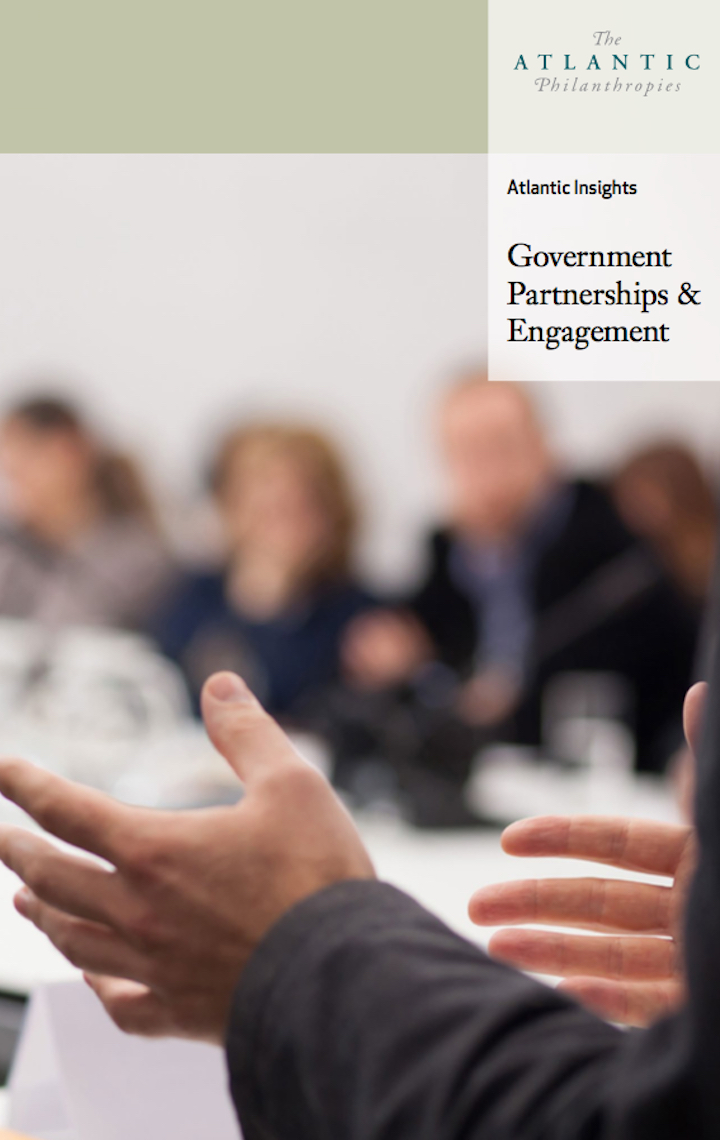Atlantic Insights Government Partnerships & Engagement
About the Book
Engaging and partnering for impact.
This book offers three case studies on how Atlantic engaged and partnered with governments around the world to ensure that public systems, services, policies and practices respond to the needs of all people, including the most vulnerable.
Case Studies:
- In the United States, the goal was to keep students off the school-to-prison pipeline by reforming punitive and unfair school discipline practices.
- In Northern Ireland and the Republic of Ireland, the foundation focused on improving life outcomes by providing preventive and early intervention services to young children.
- In Viet Nam, Atlantic supported efforts to pass a life-saving law that mandated that people riding motorbikes wear helmets.

Overview
Philanthropy’s many tools for improving social outcomes and achieving impact include the ability to partner and engage with government— to work with, alongside, against, or around government leaders and agencies to change public systems, services, and policies. For The Atlantic Philanthropies, engagement with government was a vital part of efforts to provide all people with opportunity, dignity, and equity.
In the eight places where Atlantic invested globally between 1982 and 2016 (Australia, Bermuda, Cuba, Northern Ireland, Republic of Ireland, South Africa, the United States, and Viet Nam), the foundation’s donor, staff, grantees, and other philanthropic partners worked closely with elected representatives, appointed officials, and the leaders and staff of public agencies and programs to achieve key goals.
“For Atlantic, engagement with government was vital to its efforts to provide all people with opportunity, dignity, and equity.”
Atlantic’s perspective on engagement is shaped by the foundation’s three overarching objectives:
- promoting and enhancing opportunities for people in places where systemic barriers, bias, and discrimination unfairly hold them back;
- addressing the root causes of inequity rather than the symptoms; and
- challenging and changing destructive and discriminatory practices and public narratives.
All of those goals would be difficult, if not impossible, to pursue without engaging with government in some way.
Atlantic Insights: Government Partnerships and Engagement offers direction by example, pointing out what Atlantic, its consultants, and grantees did in a variety of situations and geographies, how and why they chose one option over another, and what happened as a result. It breaks down the core elements of effective engagement as viewed through the eyes of people implementing Atlantic projects “on the ground.” And it includes comments about what participants might have done differently, given the benefit of hindsight.
“The purpose of this volume is to help people in philanthropy and in government learn what can be accomplished through mutual engagement.”
Types of Engagement
What Do We Mean By Engagement?
This Insights defines “engagement” broadly, reflecting the fact that interaction between private funders and the public sector is a multifaceted process.
- It can involve formal partnerships; informal alliances; one-on-one, direct relationships between individuals; and indirect influence through partners, coalitions, non profits, and nongovernmental organizations that advocate, mobilize, support, and apply pressure.
- It can involve working with or against government, and working to change something over which government has authority or working to change the way government itself “thinks” and operates.
- It can advance the will of the few who hold power, or it can amplify the voices of the many and the marginalized.
- It occurs at the city, state or province, and national or country levels. It can involve many different roles for philanthropy in relation to government: partner, co-funder, collaborator, connecter, innovator, supporter, challenger, and more.
- And it occurs through multiple strategies and actions: policy advocacy, legislative or administrative reforms, efforts to build physical infrastructure and human capacities, research into unmet needs and their costs, and demonstration projects to spur investment in successful responses, to name just a few. Atlantic has deployed many of these strategies, approaches, and roles to engage government in ensuring that public systems and services respond to the needs of all people, including the most vulnerable.

Key Lessons
The question shouldn't be whether to engage, but how.
The following takeaways ring true for philanthropic and government partnerships whatever the issue or geography being addressed:
- Context is paramount. Considering the circumstances, trends, available resources, and opportunities at hand, and then finding the overlap in priorities between philanthropy and government — rather than coming in with a preset agenda — can make all the difference between an engagement that gains traction and one that falls flat.
- Successful engagements often begin not with an offer of money but with a quiet phase of building relationships and paying attention to competing concerns, priorities, and constraints by gathering and examining data, asking questions, listening to knowledgeable people (including smart outsiders as well as designated experts), commissioning “think pieces,” and trying to understand what government needed to move on an issue.
- Achieving a policy win is only the first step. Monitoring and enforcing the change, and sometimes re-engaging to fix glitches, are equally important.
- Strategic framing of the issue, supported by solid data and evidence, facilitates engagement between government and philanthropy.
- Build on successful efforts already underway, when complementary efforts already exist, rather than reinvent the wheel.
Download
Knowledge you can use.
Engaging and partnering with government can be an effective way to improve public systems, services and policies. Atlantic’s experiences over the years offer lessons and guidance for other foundations and donors.
Download the full book (PDF) ›
Further Reading
